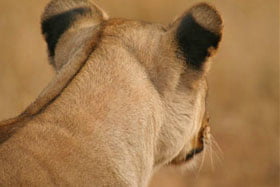Ocelli, in relation to wild cats, refers to round, white or light-colored, eye-spots on the back of the ears (the ear flaps – ‘pinnae‘). “Ocellus” is the singular. The most common example is on the wings of butterflies. For domestic cats you might see a faint version of it on tabby cats because the tabby is closest to the wild cat in terms of coat. The main picture below shows an excellent example of the ocelli on a serval cub. Servals are domesticated sometimes. When the cat positions his ears flattish and facing forwards, the ‘opponent’ sees the ocelli. I believe this is deliberate. This example of body language accompanies aggression and a signal to the other cat or animal to expect a fight. The ocelli add a threat.


The tiger has ocelli as good as the ones seen in the main photo above. The lion has dark ocelli, almost a negative image of the tiger’s. As can be seen in the picture, the bobcat has nice ocelli. The puma (mountain lion) has dark grey ear flaps with off-white ocelli. The dark background adds contrast. The jaguar’s ocelli are very similar to the mountain lion’s: dark ear flap and white spot. They are higher contrast than the puma’s. Both the snow leopard and common leopard have classic ocelli like those of the jaguar.


Good because both the tabby and torbie are tabbies really and the solids are not, so the ocelli are extinguished. This is a evolved development over thousands of years.
I never noticed that. Both my orange tabby & torbie have the ocelli, but the solid & solid and white cats do not have it.